Abstract
Visual play an important role in media reporting of news. Textual news must accompany with pictures to convey many direct and indirect meanings. Visual alone can portray thousands of meaning which unable to perform by written messages. A review of many media and communication articles showed that many researchers focused more on textual news rather than visual news. It’s seems visual portray of issues or conflict are rare. Therefore, this paper is to examine visual framing of Lahad Datu conflict coverage, which is known as Sabah standoff conflict in Malaysia, is an unforgettable tragedy until killed about 10 of Malaysian security personnel. This research is to examine visual portrayed in Lahad Datu conflict coverage in Malaysian mainstream newspapers such as Utusan Malaysia, The Star, Sin Chew and Nanban daily for the study period of one month during the crisis. With the guidance of framing analysis, researcher employed quantitative content analysis to gather the results. With 466 news coverage (288 visuals), results revealed that, the most prominence frames covered by all the four dailies were attribution of responsibility. In explaining the visual images, results noticed that images of militants and soldiers were portrayed more followed by images of decision makers. However, majority of the visual images message shown that visual portrayed a solution for an emergency situations and promoting particular parties or people.
Keywords: CrisisLahad Datu ConflictVisual Framing
Introduction
Crisis becomes a situation when a problem in a particular organization is continued with or without solution taken by responsible people. According to Coombs (1999), crisis is a sudden and unexpected event effecting an organization’s reputation in financial and reputation operation. It can make people think badly of the organization. Crises can be divided into few types, such as health crisis, economic crisis, natural disaster crisis, organization crisis, international crisis and so on.
In this research, the researcher will focus on the security crisis, also known as terrorism crisis. Crisis reporting, especially terrorism and security crisis, is a new phenomenon in developing countries like Malaysia especially on visual framing. This study will focus and examine on visual coverage of the Lahad Datu Invasion in mainstream media in Malaysia.
Lahad Datu is a small town in Tawau Division, East Malaysia. Lahad Datu Invasion is aggression by an armed group from Sulu Sultanate in Lahad Datu. In 1654, Sultan of Brunei gave Sabah to Sultan of Sulu and in 1878, Sultan of Sulu leased Sabah to the British North Borneo Company. In 1946, British North Borneo Company gave Sabah to Britain. As a consequence, in 1963 Sabah became part of Malaysia (Erman et al., 2014).
Problem Statement
On 9th February 2013, a conflict between Sulu and Malaysian security forces continued to grow, threatening the peace of the people of Sabah. A total of 100 people from the Sultanate of Sulu from southern Philippines have been smuggled into Lahad Datu, Sabah on the ground of taking back their land. They challenged Malaysia’s alleged ownership of Sabah. This negotiation has evolved into a clash of weapons of up to ten armed Malaysian personnel.
This incidence of aggression by terrorist groups in Semporna and Lahad Datu caused enormous impact to the political, social and economic situation, particularly in Sabah.
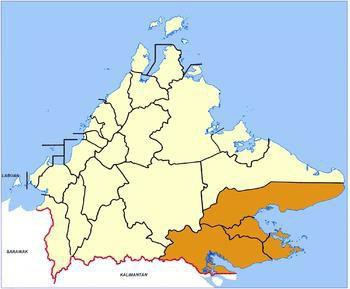
The root cause for this crisis is because the Philippines has demanded territory from Malaysia over the state of Sabah. The reason for this claim is that the territory of the Sultanate of Sulu also includes the northern part of East Borneo included in the Sulu Archipelago. The current status of the sultan is still not resolved. On 7th October 2012, President Benigno Aquino of the Philippines has announced a framework of peace agreement between the Philippines and Moro Islamic Liberation Front (MILF). However, the heirs of the Sultanate of Sulu felt left out in the negotiations. In response, Sultan Jamalul Kiram III claimed himself to be the legitimate heir to the throne of Sulu, he has decided on 11th November 2012 that the public and the military contingent should claim rights to the territory of North Borneo.
Terrorism crisis refers to the terrorist operation to attack innocent people to get something via immoral events such as bombings, creating physical damages, psychological harm to the public and so on (Zhang et al., 2013). As per figure
Research Questions
What are the elements that frame crisis?
Purpose of the Study
Purpose of this study is to examine the visual framing of “lahad datu” conflict coverage in Malaysian mainstream newspapers.
Literature Review
Crisis and Crisis of Terrorism
According to Ahmadi (2016), the word “
News is known as anything that captures the audience’s attention. One of the prominent news value is conflict. The majority of news that are covered by newspaper are either conflict or crisis news (Conley & Lamble, 2006). Newspaper coverage can have affirmative or destructive impact on the specific issue (Cheong & Zanuddin, 2017). Media plays an important part in communicating the crisis to the public. Terrorism news can’t be separated from news and news such as Iraq war, Afghanistan war, India-Pakistan war, North Korean war and other kinds of crisis news appeared in most of the local and international newspapers. Crises threaten to damage reputations because a crisis gives people reasons to think badly of the organization. News in media and the internet play a critical role during a crisis. Most of the stakeholders will learn about a crisis from news reports. “Crisis consists of five dimensions such as: ‘it is highly identifiable and can be seen by the public, needs immediate attention, uses an element of shock, needs immediate solution and that a country that faces the crisis is out of control” (Pearson & Mitroff, 1993). Adams and Roebuck (2007) said that most of the crisis happened without any expectation and preparation, it requires a surprised feeling followed by a trigger; whereby crisis can influence public’s perception of the government.
Crisis of terrorism is known as using aggressive acts of violence to harm people physically and mentally to make them scared and fearful from sabotage, riots, kidnappings, mass poisoning, rape, bombing and unlawful imprisonment (Norris et al., 2003 2003). In the United States (U.S) Marine Barracks in Beirut on October 1983, the suicide attempts succeeded after they convinced the U.S. to withdraw their soldiers from Lebanon. The same phenomena happened that resulted the U. S to pull out their soldiers from Saudi Arabia two years after the September 11, 2001 terrorist attacks. Again the same thing happened to the Filipino government when they called back their soldiers from Iraq after Iraqi extremists kidnapped a Filipino truck driver (Kydd & Walter, 2006).
Lahad Datu crisis falls into the terrorism type of crisis because according to Norris
Kydd and Walter (2006) said that terrorism works well because it causes individuals, government or state to respond to the terrorist’s goals. The first principal strategy used by terrorists is attrition. Attrition means terrorist try to persuade the enemy through showing them that the terrorists are strong enough to cause destruction. The second type of principal of terrorist strategy is to use intimidation. Intimidation is when terrorists try to convince the public through revealing that they able and willing to do any extreme things in order to affect normal citizens and trying to frame the government or authority as being incapable to stop them. The third type of terrorist strategy is to use provocation; it’s an act to persuade the government to respond to terrorists in order to stop them from violent behavior. This is followed by the use of spoiling strategy, which is using persuasion to negotiate with the government with the perception that terrorists are weak and untrustworthy, and lastly is to use outbidding when they are able to influence the public and win public support.
Media Framing
During crisis, public eager for updated information. Media is an important tool for them to gather information. This research employ Entman (1993) framing analysis because it can help to analyze visual messages portrayed in media especially in the news, and it connects news on finding the causal of problem, interpretation of problem, provide judgments and give recommendation for selected conflict news coverage. When the media place stories in specific frames, they lend a different meaning to the news. Furthermore, media’s function to increase or decrease the salience of issues, can allows the public to remember and make judgments on such issues. Media are powerful because media have the potential to shape and influence the public’s opinion and behavior (Entman, 2007). Furthermore, media is responsible to update their publics with latest and accurate information (Zanuddin & Abdoulaye, 2017).
Stories in media is used by publics to gather appropriate and updated information. The way information is transfer in news report can affect reader perceptions about the covered issue. So that, it is important for any organization, people or parties to used framing process in informing and suggesting response for a crisis (Entman, 2007). Many researchers did many studies in examining textual analysis of crisis coverage. To fill the gap, the researcher in this study used visual elements in framing analysis to examine how the visual messages was portrayed by mainstream news coverage.
Applying this framing analysis to Lahad Datu conflict can help media to portray information through selected visuals in examining how the conflict news was portrayed in newspaper to identify the main reasons for the crisis along with suggested response to overcome the conflict. The framing research in mass communication serves to illuminate the rationale behind the crisis types as crisis frames. Frames are concerned about salience or emphasis and operate on two related levels: frames in communication and frames in thought. Frames in communication involving using images, words, phrases and many other elements that can present via messages such as providing whole background story of a crisis. However, frames in thought involve the cognitive structures (such as scripts or schema) people utilize when interpreting information (Druckman, 2001). Added by Druckman, framing effects occurs when a communicator selects certain factors to emphasize. The people who receive the message will focus their attentions on those factors when forming their opinions and making judgments after read through the news.
During crisis, frame can stimulate psychological reaction among readers. Semetko and Valkenburg (2000) identified five news frames in order of predominance, they are: attribution of responsibility, conflict, economic, human interest, and morality frame. They added that the attribution of responsibility frame was the most predominantly used in crisis news coverage. The first type of frame in news is conflict frame. Conflict frame is used to portray quarrel or disagreement among individual, groups, society or country. Most of the news issue portrays conflict to grab a reader’s attention. Morality frame will direct issues or problems in the context of creating sympathy and to behave rationally. Followed by the economic consequence frame of reporting on issue that impacts the overall economic sector to individuals, groups, society or country. Human interest frame is about discussing issue to satisfy reader’s needs. Finally, the attribution of responsibility frame discusses about finding solution and recommendation for a problem.
Entman (1993) suggested that the frame can be identified and examined by “the presence or the absence of certain keywords, phrases, particular images, source of information and sentences that provide thematically reinforcing cluster, facts or judgment” and Tankard (2001) arranged the most comprehensive empirical approach for identifying and measuring news frames such as headlines, subheads, photos, photo captions, leads, sources selection, quotes selection, pull quotes, logos, statistics and charts, and concluding sentences and paragraphs. The selection of any particular framing device as suggested by Tankard can determine how the mainstream media in Malaysia framed the Lahad Datu crisis.
Frames, suggests that the mass media do even more than create saliency. By selecting what to include and what to exclude from a story, the news media frame a story. Media limit or define the story’s meaning and thereby shape people’s interpretation of that story (Hallahan, 1999). Gamson and Modigliani (1989) identify framing devices such as metaphor, exemplars, catch-phrases, depictions and visual images that provide information and offer media package of an issue.
Hallahan (1999) said that frame can be define as a message’s meaning by shaping the inferences that individuals make about the message. Journalist use frames to put information into a usable context for readers, to make stories accessible and meaningful to their audiences, and to enable readers to act upon information when appropriate. Framing is doing it’s job effectively in mass media while emphasizing issue’s importance through selection of photos, interesting texts, portraying of actors, attracting headlines and so on to define the problems and find solutions for the problems (Entman, 1993).
Visual Framing of War
Coleman (2006) said that images and visuals can add on information which is not available in printed words. Visual can be a substitute message to any printed words in disseminating message. Coleman also noted that images induce people to think deeply. He also added that photos in news can elicit more emotional responses among readers. In investigating the framing of the Iraq War in both national and foreign media, Dimitrova and Strömbäck (2005), conducted a content analysis of articles in
Carpenter (2007) conducted a content analysis comparing the visual framing of the Iraqi War in articles from elite U.S. newspapers with articles from non-elite U.S. newspapers. Carpenter found that elite publications were more likely to use visual of military frames, and non-elite newspapers were more likely to use visual of human interest or anti-war frames. Through visual framing, particular pictures and photos can create a linkage between the issues and publics in the country especially during crisis coverage. Fahmy (2007) explored visual differences in the coverage of the second Gulf War from
Dobernig and Lobinger (2010) explored differences in the coverage of the 2009 Gaza crisis in four printed news sources in Palestinian press and Israeli press. Study found out, Palestinian press using individual civilians as visual representation which portrayed a sense of empathy, while the Israeli press was represented by visuals of political or governmental officials portraying responsibility and responses. Schwalbe (Schwalbe) did a visual content analysis study to examine visual portrayal of the Iraq war in
A study by Ben-Yehuda
Research Methods
This study employed quantitative content analysis in order to achieve the research objective. Content media research methodology has been used extensively by many media researchers (Amahallawi & Zanuddin, 2017; Cheong & Zanuddin, 2017; Watimin & Zanuddin, 2017). Four selected Malaysian mainstream newspapers were chosen for this study based on their circulation in the Audit Bureau Circulation Malaysia (Refer to Table
The selection of newspapers in this study were selected from three different ethnic orientation such as
Findings
The Coverage
This study has found 466 news of Lahad Datu crisis throughout four newspapers from 9th February until 31st of March 2013. Since Lahad Datu crisis is an unusual situation among publics in Malaysia, researcher interested to know about the frequency of news in all mainstream newspaper in Malaysia.
Table
News Framing
According to Entman (1993) & Hallahan (1999), frames can shape people’s perception through the use of themes, word, headline, paragraph and some other elements in writing news and portraying pictures in media. In this study, the researcher was able to figure out the highest and most dominant frames employed in all of the mainstream dailies in Malaysia. The
Visual frequency of Lahad Datu crisis
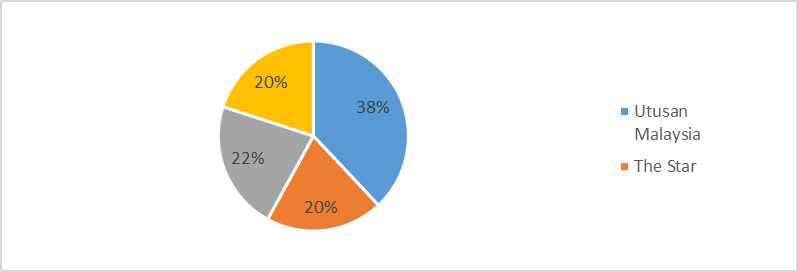
Coleman said images can induce people to think deeply about the issue and he added that photos in news can elicit more emotional responses among readers. In agreeing with his information, one of the variable for this research is visual framing of the Lahad Datu conflict. Overall, from 466 news on Lahad Datu issue, the data depicted 288 visual images for it. Among the 288 visuals, as listed in figure
Visuals in the
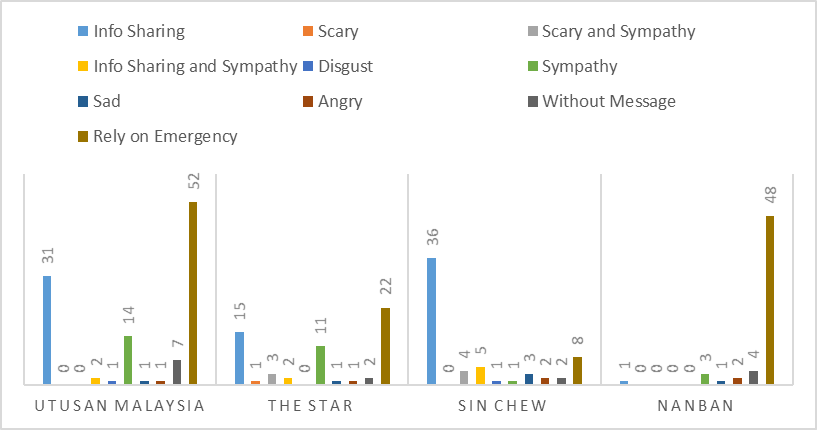
Portrayal of Lahad Datu Images and Newspapers
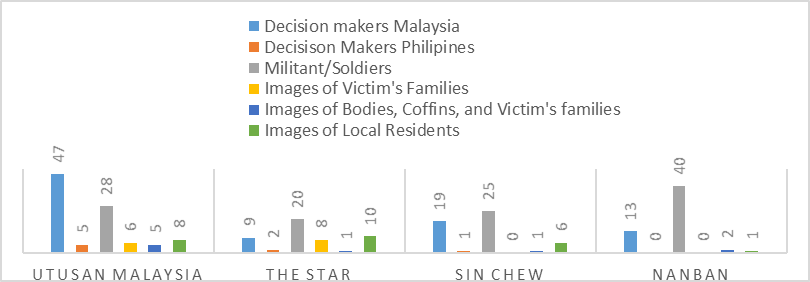
For the portrayal of visual images for the selected period, data revealed that, visual of militants and soldiers of Malaysian security personnel were portrayed most which is 113 articles. Similar findings were depicted with Dimitrova and Strömbäck (2005) & Carpenter Carpenter (2007), founded the emphasized visuals were on military operations, troops, arsenal, and combat visual images. Images of Malaysian decision makers and politician images is in second highest which is 88 articles is accordance with previous studies by Dobernig and Lobinger (2010), Schwalbe (2013) & and (Ben-Yehuda
Images of local residents and villagers from Sabah appeared most in
Images of militant and soldiers were portrayed most in
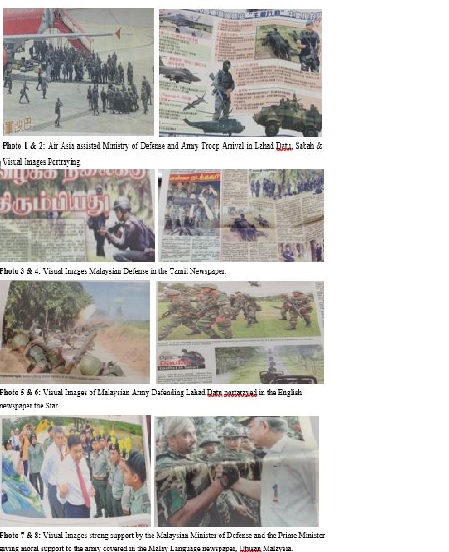
Conclusion
Quantitative content analysis, together with systematic coding book were able to deliver some interesting and useful data for further understanding of the elements and variables to frame crisis effectively. Throughout this research, the results depicted that 466 news about Lahad Datu crisis were found in the duration of study.
References
- Adams, J. S., and Roebuck, D. B. (2007). Exploring neglected terrain: Communication with employees during crises. Organizational Development Journal, 15, 63-72.
- Ahmadi, I. (2016). Role of Media on Crisis Management. Journal of Exploratory Studies in Law and Management, 2(3).
- Alyousef, Y., and Zanuddin, H. (2017). Saudi Arabian government crisis management and prevention strategies: Has it been effective to curb the presence of radical groups in the social media? Paper presented at the Asia International Multidisciplinary Conference, UTM Johor, Malaysia.
- Amahallawi, W., and Zanuddin, H. (2017). 50 days of war on innocent civilian: Ma'an news agency coverage of Israeli and Palestinian conflict. Paper presented at the Asia International Multidisciplinary Conference, UTM Johor, Malaysia.
- Ben-Yehuda, H., Naveh, C., and Levin-Banchik, L. (2013). When media and world politics meet: Crisis press coverage in the Arab–Israel and East–West conflicts. Media, war & conflict, 6(1), 71-92.
- Carpenter, S. (2007). US elite and non-elite newspapers' portrayal of the Iraq War: A comparison of frames and source use. Journalism & Mass Communication Quarterly, 84(4), 761-776.
- Chang, P. K. (2009). Comparison of media and source framing in selected Chinese newspaper stories on bilingual education issues in Malaysia. Unpublished Doctoral of Philosophy's Thesis. Universiti Putra Malaysia. Kuala Lumpur.
- Cheong, J. R., and Zanuddin, H. (2017). Media attention for climate change mitigation and adaptation in Malaysia: A comparative analysis of Malaysia Chinese newspapers coverage. Paper presented at the Asia International Multidisciplinary Conference, UTM Johor, Malaysia.
- Coleman, R. (2006). The effects of visuals on ethical reasoning: What's a photograph worth to journalists making moral decisions? Journalism & Mass Communication Quarterly, 83(4), 835-850.
- Conley, D., and Lamble, S. (2006). The daily miracle: An introduction to journalism. South Melbourne: Oxford University Press.
- Coombs, W. T. (1999). Ongoing crisis communication: Planning, managing, and responding. Thousand Oaks, CA: Sage.
- Coombs, W. T. (2007). Ongoing crisis communication: Planning, managing, and responding (2nd ed.). Thousand Oaks, CA: Sage.
- Coombs, W. T., and Holladay, S. J. (2009). Further explorations of post-crisis communication: Effects of media and response strategies on perceptions and intentions. Public Relations Review, 35(1), 1-6.
- Dimitrova, D. V., and Connolly-Ahern, C. (2007). A tale of two wars: Framing analysis of online news sites in coalition countries and the Arab world during the Iraq war. The Howard Journal of Communications, 18(2), 153-168.
- Dimitrova, D. V., and Strömbäck, J. (2005). Mission accomplished? Framing of the Iraq War in the elite newspapers in Sweden and the United States. Gazette (Leiden, Netherlands), 67(5), 399-417.
- Dimitrova, D. V., and Strömbäck, J. (2012). Election news in Sweden and the United States: A comparative study of sources and media frames. Journalism, 13(5), 604-619.
- Dobernig, K., and Lobinger, K. (2010). Covering conflict: Differences in visual and verbal news coverage of the Gaza crisis 2009 in four weekly news media. Journal of Visual Literacy, 29(1), 88-105.
- Druckman, J. N. (2001). The implications of framing effects for citizen competence. Political behavior, 23(3), 225-256.
- Entman, R. M. (1993). Framing: Toward clarification of a fractured paradigm. Journal of communication, 43(4), 51-58.
- Entman, R. M. (2007). Framing bias: Media in the distribution of power. Journal of communication, 57(1), 163-173.
- Erman, A., Chang, P. K., and Zawawi, J. W. M. (2014). Political discourse in Indonesia and Malaysia for National Human Security: A case study of Lahad Datu. Jurnal Komunikasi, Malaysian Journal of Communication, 30(2).
- Fahmy, S. (2007). “They Took It Down”: exploring determinants of visual reporting in the toppling of the Saddam statue in national and international newspapers. Mass Communication & Society, 10(2), 143-170.
- Gamson, W. A., and Modigliani, A. (1989). Media discourse and public opinion on nuclear power: A constructionist approach. American journal of sociology, 95(1), 1-37.
- Hallahan, K. (1999). Seven models of framing: Implications for public relations. Journal of public relations research, 11(3), 205-242.
- Holladay, S. J. (2009). Crisis communication strategies in the media coverage of chemical accidents. Journal of public relations research, 21(2), 208-217.
- Kydd, A. H., and Walter, B. F. (2006). The strategies of terrorism. International Security, 31(1), 49-80.
- Norris, P., Kern, M., and Just, M. R. (2003). Framing terrorism: The news media, the government, and the public: Psychology Press.
- Pearson, C. M., and Mitroff, I. I. (1993). From crisis prone to crisis prepared: A framework for crisis management. The academy of management executive, 7(1), 48-59.
- Qureshi, M. I., Rasli, A. M., and Zaman, K. (2016). Energy crisis, greenhouse gas emissions and sectoral growth reforms: Repairing the fabricated mosaic. Journal of Cleaner Production, 112, 3657-3666.
- Schwalbe, C. B. (2013). Visually framing the invasion and occupation of Iraq in Time, Newsweek, and US News & World Report. International Journal of Communication, 7, 239-262.
- Semetko, H. A., and Valkenburg, P. M. (2000). Framing European politics: A content analysis of press and television news. Journal of communication, 50(2), 93-109.
- Tankard, J. W. (2001). The empirical approach to the study of media framing (Stephen D. Reese, Oscar H. Gandy and A. E. G. Jr. Eds.). New Jersey: Lawrence Erlbaum Associates.
- Watimin, N. H., and Zanuddin, H. (2017). Managing crisis and response times analysis: The effectiveness of online monitoring strategy analysis in plaza low yat racial riots incident and bersih 4.0. . Paper presented at the Asia International Multidisciplinary Conference, UTM Johor, Malaysia.
- Wimmer, R. D., and Dominick, J. R. (2013). Mass media research: An introduction. Belmont: Wadsworth.
- Zanuddin, H., and Abdoulaye, O. K. (2017). Health public relations campaign and online news coverage focus: Does it help public health policy and the people of Cote d'Ivoire (Ivory Coast)? Paper presented at the Asia International Multidisciplinary Conference, UTM Johor, Malaysia.
- Zanuddin, H., and Amahallawi, W. (2017). Media framing approach of Israelis and Palestinian conflict: Ma'an news coverage onwar, pain and humanitarian issues. Paper presented at the Asia International Multidisciplinary Conference, UTM Johor, Malaysia.
- Zhang, D., Shoemaker, P. J., and Wang, X. (2013). Reality and newsworthiness: Press coverage of international terrorism by China and the United States. Asian Journal of Communication, 23(5), 449-471.
Copyright information

This work is licensed under a Creative Commons Attribution-NonCommercial-NoDerivatives 4.0 International License.
About this article
Publication Date
01 May 2018
Article Doi
eBook ISBN
978-1-80296-039-6
Publisher
Future Academy
Volume
40
Print ISBN (optional)
-
Edition Number
1st Edition
Pages
1-1231
Subjects
Business, innovation, sustainability, environment, green business, environmental issues
Cite this article as:
Zanuddin, H., & Ambikapathy, M. (2018). Visual Framing Of “Lahad Datu” Conflict Coverage In Malaysian Mainstream Newspapers. In M. Imran Qureshi (Ed.), Technology & Society: A Multidisciplinary Pathway for Sustainable Development, vol 40. European Proceedings of Social and Behavioural Sciences (pp. 666-681). Future Academy. https://doi.org/10.15405/epsbs.2018.05.55

